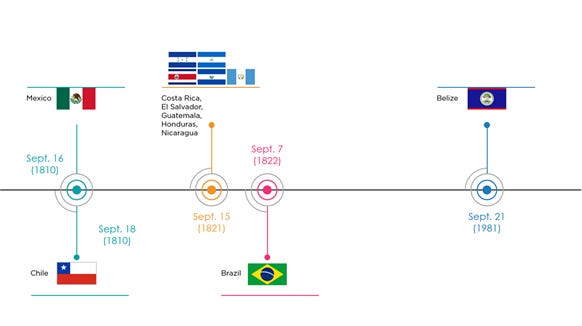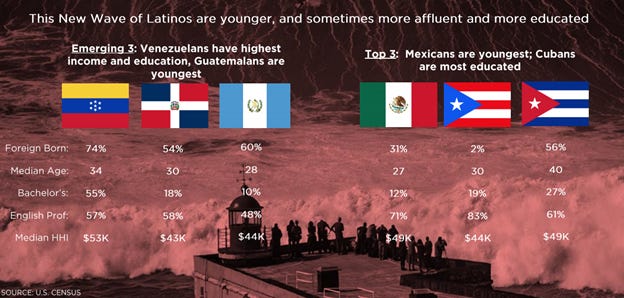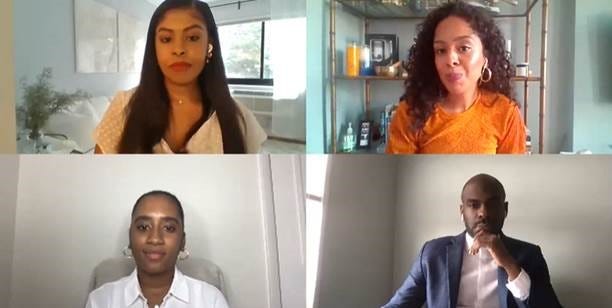Audiences Uncovered: Hispanic/Latino Audiences
Hello Everyone! As a reminder, we are LIVE on Substack, where you can find all of the past and future editions of our newsletter.
As we're sure all of you are aware, over the course of the past 31 days, from September 15th through October 15th, we celebrate Hispanic Heritage Month. So, this Audiences Uncovered newsletter is a deep dive on Hispanic/Latino audiences. Being the youngest, fastest growing and economically powerful segment in America today makes understanding and connecting with Hispanic/Latino Consumers essential for sustained business growth. However, as we strive to build relationships, we must ensure that the value exchange moves in both directions.
This report includes some brilliant insights from our partners at IDENTITY and the El Nuevo5 report. You can download their full report here.
This edition of Audiences Uncovered is 1,690 words approximately a 6 min read
By the numbers
28: The median age of Latino Americans (vs. 43 for NH Whites) (Pew Research Center)
1 in 4: US Latinos have heard of "Latinx" but just 3% say they use the term (Pew Research Center)
8th: Largest economy in the world if Latinos’ GDP were it's own country (El Nuevo5)
$1.9 Trillion: in Latino purchasing power (El Nuevo5)
55: years of expected effective spending power (vs. 37 for NH whites)
49: percent of Latino adults who consider themselves Indigenous or Afro-Latino (Pew)
34: percent growth over 10 years in the number of Latino business owners (compared to 1% for all US) (SLEI)
Half: of YouTube’s Top 10 in 2019 were Spanish language songs (BBC)
A Bit of ‘Hispanic Heritage Month’ History
Have you wondered why the observance of Hispanic Heritage Month begins in the middle of the month? Well, the reason the celebration runs from September 15th is that several Latin American countries have their Independence Day celebrations on the heels of one another.
32 years ago, in 1988, the bill extending the observance to 31 days from a week was signed into law. Esteban Torres, one of the vanguards of Latino influence in Politics, noted what he and supporters of his extension bill wanted to achieve:
“We want the American people to learn of our heritage. We want the public to know that we share a legacy with the rest of the country, a legacy that includes artists, writers, Olympic champions, and leaders in business, government, cinema, and science.”
Latino vs. Hispanic vs. Latinx
Art by Alan Lopez for Remezcla
In 2012— lifetimes ago in the world of multicultural research— Pew found that a slight majority of respondents (51%) preferred to define themselves by their family’s country of origin. “Hispanic/Latino” (note: grouped together at the time) was in second place at 24% followed by “American” (21%). Newer research shows how much times have changed. Although the gender-neutral term “Latinx” has grown in popularity in recent years — especially among younger or more progressive circles— “Hispanic” is now the term that resonates the most broadly (ThinkNow).
But, wait! There are a few nuances.
Black Latinos are less likely to identify with '“Hispanic” than white Hispanics or indigenous Hispanics (2020 MiM), likely due to association with Spanish colonialism. Although foreign born Hispanics still rank “Hispanic” as their number one preferred term, they are significantly more likely than US born Hispanics to prefer “Latino/Latina” (ThinkNow).
When speaking to multicultural audiences, keep this is mind.
It’s always best to ask how someone identifies and respect their personal preferences; however, marketers don’t always have that luxury. For brands looking to be sensitive, you can default to the preference of the majority. However, it’s important to consider intersections within the audience being targeted and how race and gender non-conforming subsets might feel about terms that historically have erased parts of their identities.
As a 2018 Remezcla article states, “for groups often excluded from the discourse, words like Afro-Latino, Muslim Latinos, and Asian Latinos have helped to center their experiences”.
Although “Hispanic” is a safe bet now, with a population growing younger and more multicultural, in a few years that may not be the case.
Impact of COVID-19
While the COVID-19 pandemic may have been indiscriminate in its wide reaching spread, its effects have been anything but equal. The pandemic has uncovered and exasperated the widening gulfs between many subsets of the population.
Latino Americans, one such population, have been adversely impacted from COVID-19, in a variety of areas – physically and financially.
Latinos make up a disproportionate share of mortalities.
(CDC, NPR; note: this pattern is also true for African Americans and Native Americans).
Unemployment rises especially among women.
Additionally, the unemployment rate for Latinos increased from 4.8% in February to a high of 18.5% in April before dropping to 14.5% in June. This exceeds levels from the Great Recession, when the unemployment rate peaked at 13.9%. Women have experienced an even steeper rise in their unemployment rate, going from 5.5% in February to 20.5% in April.
Over represented compared to NH whites in essential workforce & dense living situations.
Although the higher death rate was initially explained as Latinos having greater incidences of comorbidities, new CDC data reveals a significant imbalance in the number of virus cases, not just deaths — a fact that highlights systemic inequities beyond just other health issues.
In the U.S., nearly 25% of employed Latino and Black or African Americans work in the service industry, compared with 16% of non-Hispanic white workers.
According to the American Housing Survey, Latino people are twice as likely to reside in a crowded dwelling — defined as less than 500 square feet per person — as non-Hispanic whites, making it harder for them to quarantine away from others if they are infected (NYT).
Not surprisingly, the psychological toll on Hispanics has also been harder.
Hispanic adults cite the highest instances of feelings of depression and anxiety and are less likely than the average American to feel “hopeful”.
September 2020 COVID-19 Intelligence Report
Looking to Brands for help.
Although systemic issues require system changes, research shows that consumers also have expectations of brands to get involved. Procter & Gamble recently teamed up with the We Are All Human Foundation on their ‘Estamos Unidos’ (translation: ‘We are United’) campaign, to address the fact that “Hispanics are disproportionately on the front lines of the pandemic—both as workers and casualties of the economic fallout” (Ad Age).
Recognizing that there will be challenges ahead, it is important to double down on efforts to help these communities stay afloat. Considering the current socio-political climate (and recent events highlighting the need for equality intervention), there is no better time to take action and understand brands’ broader responsibility to these communities and cultures.
Latinos as consumers
Latino consumers wield enormous spending power, projected to almost triple by 2023 (Identity). This in addition to their relative youth means a consumer value well worth investing in.
Not only are Latinos collectively spending trillions, their brand usage over-indexes across the J&J portfolio — especially within ‘PEDS/baby’.
Research shows that Latino consumers have an affinity for brand names, turning to them for perceived greater efficacy and quality over private label — especially when it comes to self care (i.e. pain medicine, allergy, oral health).
35.2% “always look for brand name”, 11% higher than total pop (2020 MiM)
10% less likely to agree that “store brands work like advertised brands” than total pop (2020 MiM)
79% more likely to agree that “the most expensive meds usually work the best” (2020 MiM)
Above: 2020 MiM data showing that Latinos (especially those not born in the U.S.) are more likely to purchase brand names than they are to purchase private label or store brand. Note: Latinos overindex for private label skin health/baby brands because they overindex across skin health and baby in general. Indices are still higher for brands.
Exploring Latino Identity in America today
There’s breadth and depth in diversity and growth.
In 2003, Latino Americans officially became the largest ethnic minority group in America. In the years since, the Latino population has continued to drive overall population growth primarily among U.S. Latinos. While Mexican Americans comprise the largest share at roughly 65%, we’ve seen steady growth from Guatemalans, Dominicans and Venezuelans bringing a wave of new opportunities among younger and more affluent audiences.
Answering “what box do I check?” isn’t always straightforward.
Last week, many of us (virtually) attended the amazing Real Talk Series exploring the intersection of Afro & Latino. UM Panelists Joan De Jesus and Cheyla Shabazz along with guests Clarissa Arnao and Claudio Cabrera shared their experiences navigating common misconceptions, communication pitfalls, and projections made by society at large when confronting Afro-Latino identitiy. In a time where there’s a collective reckoning of issues surrounding race, inclusivity, and diversity, it showed the importance of including diverse voices and narratives in the work that we do — and embodying diversity in our daily lives. If you weren't able to join the live session, you can view the discussion at your leisure over on Microsoft Stream.
"Afro-Latina is a duality that many other people struggle to process." — Clarissa Arnao
Language can wear many hats.
Language is important because it's how we communicate, but language can also be a unifying identity between members of a culture. Among Latino Americans, there are nuances to how language manifests in the daily conversations and consumption of language. In many households, you will find an interplay between Spanish and English often enhanced by multi-generational connections.
Over the past few years, there's been an increase in the desire of Millennials and GenZ to speak and consume the language of their heritage. 57% of Latinos agree that the Spanish language is more important to them than it was five years ago and 62% of Millennials report a higher interest in the language.
Thus, suggesting that Spanish is both circumstantial and a choice for these segments – they are most likely to speak/consume it in instances when it makes most sense (i.e. watching a soccer game in Spanish vs. watching an NFL game in English).
The 200 Percenter mentality is in.
Why choose one or the other when you can have both? The 200 percenters represent roughly 20 million Millennials who see themselves as 100% American and 100% Latino. What's special about this group is that they are largely the first generation that doesn't have to choose between their American and Latino identities and can outwardly claim and embrace each.
While older Latinos recall feelings of needing to blend in their youth, Latino millennials in comparison to their parents and grandparents are less likely to feel the same pressure to assimilate. Instead, we see younger generations hold their heritage at the center and allow it to blend outward into the mainstream. What this reveals is the two-way street upon which both cultures are shaped and the ways in which the concept of biculturality thrives over cultural assimilation.
Voices that are influential and far reaching.
We mentioned how the process is a two-way street and actively ‘blending out’ weaves elements of Latino culture permanently into America's fabric. Powerful influences of their music, politics and pop culture to style and food, have come to be seen as a key pieces of the broader American culture.
Millennials resoundingly see our nation's cultural diversity as one of its best assets and this is especially true for multicultural audiences.
Percentage of millennials from all ethnic backgrounds that Agree "Cultural Diversity is one of America's major sources of strength":
Kantar Monitor Study
When it comes to representation, there’s work to be done.
As we recognize the strength of cultural diversity and the effect that ethnic segments have on shaping overall mainstream American culture, it's important to acknowledge the visibility void in media shaped by a lack of representation.
Though Latino American's agree that they see their influence reflected in numerous categories, they also don’t feel that they are being represented. This reveals an opportunity for a greater dialogue so that Latino Americans feel seen and heard.
What brands are doing
Google’s Doodle highlights a pioneer, Felicitas Mendez.
The Converse ¡Mi Gente! Collection inspires creativity.
P&G calls for unity.
Getting Quinceañera-ready with NEUTROGENA® Pink Grapefruit Oil Free Acne Wash
No teenager wants to face the day with acne — especially if it’s a special occasion. Our J3 Studio team sought to build familiarity, favorability and purchase intent among teens and did so by aligning culturally relevant content with a key moment for Latina American teen girls, her Quinceañera.
Partnering with Telemundo we tapped into their strength as an endemic platform as their social-first docu-series explored 5 real-life Quinceañera stories. The campaign resulted in lift across all KPIs and market share growth for NEUTROGENA® Acne. For more information on this campaign, reach out to Niki Schloss or Anthony Hello.
Extra credit reading
Why We Say Latinx: Trans & Gender Non-conforming People Explain (Latina)
What Does It Mean to Be Latinx? For Some, It's the ‘One Term That Gives Everyone a Home’ (VOGUE)
Afro-Latino: A deeply rooted Identity Among US Hispanics (Pew Research)
Young Latinos Lean On Plants For Comfort And Cultural Connections During The Pandemic (NPR Chicago)
Julián Castro can’t speak Spanish. Here’s why that’s so authentic. (Washington Post)
Young Latinos use virtual reality to reunite immigrant families separated by borders (NBC)
'L' is for Latino: Sesame Street's 50 years of positive Latino characters (NBC)
Meet the Chicanos of Japan (CityLab)























